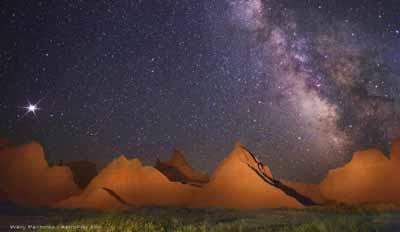As you plan your park travels for the summer, don't overlook Badlands National Park's outstanding Night Sky Program. The combination of dark skies, a chance to look through top-quality telescopes and excellent interpretation provides a rare chance to see and enjoy the wonders of the heavens in ways most of us have never experienced.
Many visitors to Badlands take a brief detour from Interstate 90 to zip through the area as they drive across South Dakota en route to or from larger parks such as Yellowstone. Although even a brief visit is better than none, that's a shame, because this is an area where the scenery is at its best in the morning and evening light…and you can't enjoy some of the most spectacular views until after dark.
These wide open spaces are far removed from major sources of light pollution and Badlands offer wonderful chances to enjoy the night sky. From May 29 until September 10 this summer, the park is offering its Night Sky Program Friday through Monday nights at the Cedar Pass Campground Amphitheater.
Interpreters present a 40-minute multi-media presentation about the wonders of the dark night sky, followed by a "Tour of the Universe." The ranger will point out constellations with the help of a powerful green laser, and then night sky volunteers will give visitors of all ages a chance to share views of the night sky through high-quality telescopes.
Larry Smith is the park's Night Sky Program Interpreter, and he says most people have never had a chance to view the sky through a telescope. During these programs, Smith says visitors may have the chance to view "not only galaxies but also star clusters, nebulae, planets and moons." When the program schedules coincide with those overhead, visitors are also treated to views of fly-overs by numerous satellites and the International Space Station.
In addition to individual viewing of celestial objects, the programs often include some impressive "big-screen" displays. A special camera mounted to a telescope allows live images from the telescope to be displayed on a 25 foot by 30-foot screen, and Smith says the stunning close-ups of the moon invariably prompt plenty of spontaneous "Wows!"
Perhaps most impressive for many visitors is the stunning view of the Milky Way. Smith recounted a story from one of his evening programs, when a young girl who was sitting next to him during his introductory talk kept interrupting his presentation with a persistent inquiry for "Mister Ranger." She was obviously quite anxious about something, so he stopped and asked how he could help.
Her reply was that she and her family "had driven all the way from Dallas to see the stars, and now that cloud in the sky was going to spoil the whole thing!"
The "cloud" was the Milky Way, but she could be forgiven for her mistake. Most Americans have never seen the stunning Badlands version of that feature of the night sky. The little girls was relieved—and very impressed!
Starting times for the programs vary based on the time of sunset during the summer, ranging from 9:00 p.m. in late May to 8:00 p.m. in early September. This park brochure includes those times, along with information on other ranger-guided programs at Badlands this summer.
The park website also includes information on overnight lodging and camping in the park and other details to help plan a visit to Badlands National Park.
If you have a love for astronomy and natural dark skies and want to share those interests with others, consider applying for a position as a Volunteer In Park (VIP) Night Sky Assistant. That link includes contact information for the park's VIP Coordinator.


 Support Essential Coverage of Essential Places
Support Essential Coverage of Essential Places







Comments
The last time I visited Badlands National Park I did not participate in the evening programs. This may be just the excuse I need to go back has I have wanted to re-visit the Badlands and explore more areas. What a great area to gaze up at all that is going on in the sky during the night. My children have been asking about camping this summer. Could do both on a summer trip to the Badlands even though we are planning on visiting other National Parks already.
The National Parks are some of the best places to see pristinely dark skies. Going on now through March 4 is the citizen-science campaign, GLOBE at Night. GLOBE at Night asks peope to measure their night sky brightness by looking at the constellation Leo and comparing it to several charts that have differing numbers of stars. In a national park you would pick the last chart (typically) with the most stars, but in NYC, it would probably be the first chart with the least number of stars. The measurement can be submitted via smart phone, tablet or computer. It is fun and easy to do and just takes a few minutes. By recording more measurements of the night sky brightness levels in neighborhoods and national parks, people are using this information in local decisions on how to increase safety, lower energy consumption, and protect human health and wildlife -- areas affected by high levels of extraneous light. These observations will also help identify parks suitable for urban "sky oases"- places that can be developed to help city dwellers appreciate the night sky from a safe, dark place.